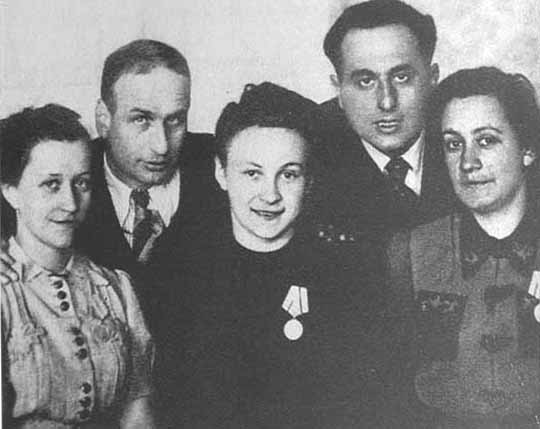Lost Jewish Worlds |
|||||
|
Home | |
Grodno to WWI | |
Between the Wars . . . 1. Demographic Changes 2. Antisemitism & Pogroms 3. Education & Religion 4. Cultural Life 5. Political Activity |
| Under Soviet Rule | |
German Occupation . . . 1. Fall of the City 2. Deportations to the Ghetto 3. Confiscation & Forced Labor 4. Liquidation of the Ghetto 5. Underground Activities 6. After the War |
| Bibliography |
THE GERMAN OCCUPATION - 6
AFTER THE WAR
On July 14, 1944, Grodno was liberated by the Red Army. The �Across the River� suburb and Lososna were liberated ten days later, after a stiff resistance of the Germans. Some forty to fifty Jews who had been in hiding in the city and its environs emerged, and they were soon followed by the return of some of the youngsters who had fought with the partisans. Slowly but steadily, other survivors arrived, most of them from the USSR, in the hope of finding relatives and friends who had come through the war. But most of the returnees quickly left. Many went to Palestine after passing through several transit stations in Europe; some immigrated to the United States or Latin America; and others made their way to Russia. There were about 200 survivors in Grodno. In the following years also Jews from other places settled in Grodno, and slowly their number rose until it reached approximately 2,000 people.
During the emigration waves of the years 1945-1946, 1957-1958, and 1972-1973, many Jews left Grodno � most of them to Israel, but also to the United States and other countries.
Before the �Peristroika� period, no Jewish life existed in Grodno; there was no synagogue, no Jewish cultural events, not even a Jewish cemetery. In the 1950s the authorities turned the main Jewish cemetery in Grodno into a stadium. The Jewish cemetery in the �Across the River� suburb was closed as well, and the Jews had no choice but to bury their dead in the non-Jewish cemetery.
The changes that transpired in the former Soviet Union in the late 1980s gradually brought a rejuvenation of Jewish life in Grodno as well. On October 18, 1989, a Jewish cultural association was established that bore the name of Leib Naidus. Since April 1992, a small Jewish religious community exists in Grodno, and the authorities returned to them the Great Synagogue � although in very bad condition. Dr. Felix Zandman, today the owner of the �Vishay� electronics concern, financed the renovation. That same year a Sunday School for Jewish children was opened, where they learn Hebrew, Jewish history, Jewish religion etc.
In this period Jewish emigration from Grodno, mainly to Israel, increased. By the end of 1995, some 1,000 Jews remained in Grodno (out of a population of more than 250,000 inhabitants). Of them only five are former Grodno residents who survived the Holocaust, returned to their native town, and chose to remain. A request by Salomon Zhukovsky to the city�s Soviet mayor to erect a monument to the Jews of Grodno who had perished in the Holocaust was rejected. The mayor claimed that insufficient documentary evidence existed about such a large number of victims. It was not until Zhukovsky showed the mayor a series of publications that contained documentary proof,35 that the municipality agreed to his request. On March 12, 1992, a plaque commemorating the Holocaust victims from Grodno was placed at the entrance to the ghetto.
35 Klarsfeld, op. cit.
Trials of War Criminals. Of the four major war criminals who were involved in the annihilation of the Jews of Grodno and its surroundings � Heinz Errelis, Kurt Wiese, Otto Streblow, and Karl Rinzler � the first two were brought to trial. Errelis�s deputy Schott, killed himself after the war. Streblow was apparently killed in action, and Rinzler, the sadistic commandant of Kielbasin camp, disappeared. At the very end of the war (May 12, 1945), the British arrested Errelis, but, in 1947, he escaped from a POW camp at Rimini, Italy, and disappeared without a trace. Wiese also vanished. It was Schott�s interrogation that led to the arrest of Errelis and Wiese. In 1960, a few survivors from Grodno were invited to testify at the trials in Ludwigsburg, Germany. Both war criminals were convicted, but Wiese was freed on bail and disappeared again; he was apparently smuggled out of the country by the Nazi underground organization that helped war criminals escape. In 1964, the Nazi-hunter Simon Wiesenthal discovered his whereabouts, and he was caught while trying to reach Egypt. In 1966�1967 he was tried in Bielefeld, Germany, together with Errelis and other Gestapo personnel who had been active in the Bialystok area. The court acquitted Errelis of charges of direct involvement in murder for lack of evidence. He was found guilty only of complicity in the murder of the Jews of Grodno in Ghetto One and of the Jews in the Bialystok ghetto, to which he was posted following the liquidation of the Grodno ghettos. The sentences were handed down in April 1967. Errelis received six and a half years in prison and was deprived of German citizenship for five years. Wiese was convicted of murder and complicity in murder and received seven consecutive life terms. In 1968, the two were also tried in Cologne, together with other war criminals who had been active in Grodno.37
37 Serge Klarsfeld, Documents Concerning the Murder of 29,000 Jews of Grodno by the Germans, 1941-1943, Tel Aviv, 1989.
 Group of partisans and survivors from Grodno immediately after the liberation (with
Group of partisans and survivors from Grodno immediately after the liberation (with
medals). Clockwise, from upper left: Sender Freydovicz, Joszi Weis, Ania Rud,
Lisa Chapnil, Chasia Bornstein-Bielicki.
Home